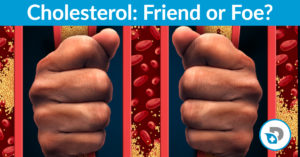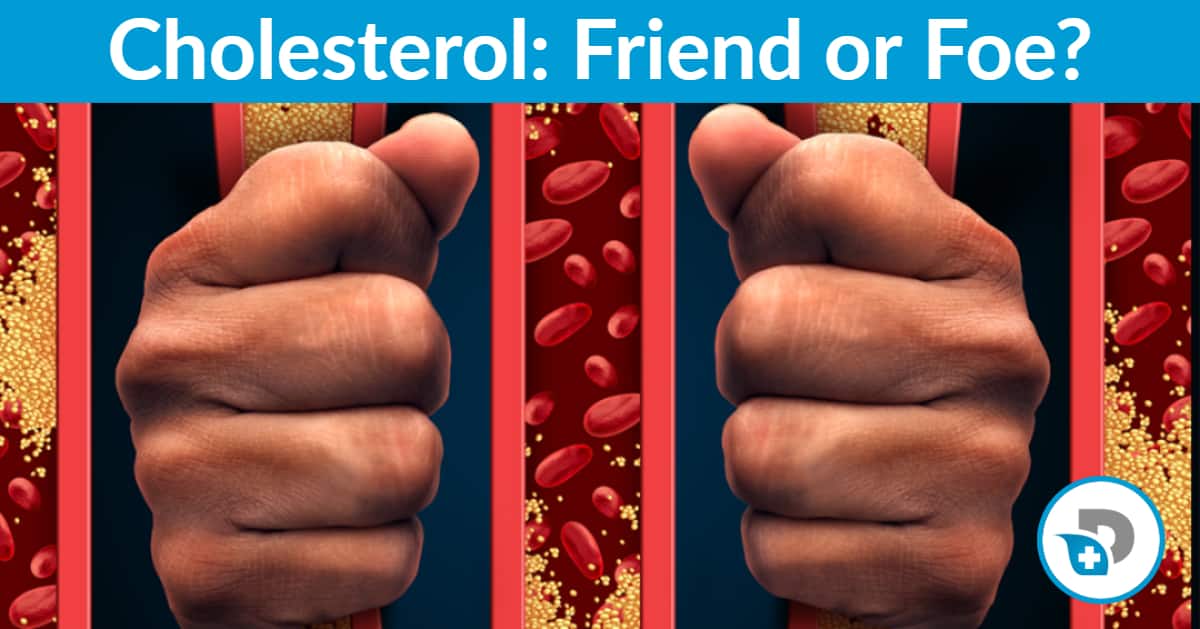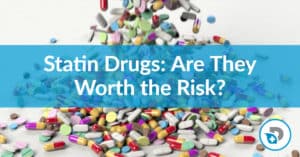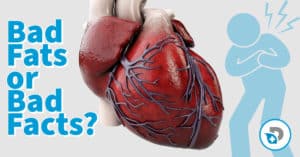
Cholesterol: Friend or Foe?
- by Dr. Daniel
- Published on

Cholesterol has earned quite a mighty reputation over the last few decades; and not in a good sense.
Synonymous with plaque formation in the arteries and heart disease, high cholesterol has possibly become one of the most dreaded words a doctor can bring up.
But do you really need to worry about high cholesterol?
In a previous article, we unraveled some big and popular myths surrounding saturated fat and explained how despite the low-fat craze, the rate of heart disease in the country is on the rise.
It is now time to explore some startling truths about cholesterol – possibly one of the most feared and misunderstood molecules there is.
What if I told you that cholesterol is your friend?
And without cholesterol you would die?
And most importantly, how cholesterol is not the main player in the development and progression of heart disease, as we have been led to believe?
Half of the people with heart disease do not have high cholesterol levels.
Half of the people with high cholesterol levels do not have heart disease.
Total cholesterol levels are a poor predictor of heart attacks.
If high cholesterol is not the main underlying cause of heart disease, what is? Is there another factor at play?
What Is Cholesterol?
Cholesterol is a soft, waxy substance found in every cell of the body.
Your liver produces about three-quarters of your body's cholesterol.
And as typically believed, cholesterol is not essentially a fat; it is a sterol – made up of steroid and alcohol.
What makes cholesterol so important that it is found in every cell around the body?
- This means that cholesterol is a primary structure of the cell walls that make up every single cell in your body. It gives them just the right structure and stiffness while also maintaining their flexibility.
- Facilitates communication between the cells.
- Helps in smooth functioning of brain and nervous system; helps in nerve transmission and particularly important for memory formation.
- Acts as a precursor (starting raw material) for the production of vitamin D and many steroid hormones such as estrogen, progesterone, testosterone, cortisol and aldosterone.
- Helps in making bile acids, that helps the absorption of fat from the intestine.
- Acts as an anti-oxidant and anti-inflammatory. It helps repair damaged and inflamed tissues (including arteries).
Being fat soluble, cholesterol can’t mix freely with water.
Since water is mostly blood, cholesterol needs some help to float through the blood stream; and it does with the help of Lipoproteins.
Lipoproteins are small spheres made up of proteins (apolipoproteins), phospholipids, triglycerides and cholesterol.
Like submarines, these small packets carry cholesterol from one place to another in the blood.
Lipoproteins are classified depending on the type of proteins that carry the lipid molecules.
There are many types of lipoproteins, for example, chylomicrons, very low-density lipoprotein (VLDL), low density lipoproteins (LDL) and high density lipoproteins (HDL). Chylomicrons and VLDL mostly carry triglycerides but also contain small amounts of cholesterol.
Low-density lipoprotein (LDL): LDL carries cholesterol from the liver to cells and tissues, including the arteries.
LDL is also called “bad cholesterol” because it is known to contribute to atherosclerosis – excessive build up plaque or fatty materials within the arterial wall that hardens and clogs the arteries.
Atherosclerosis is one of the major risk factors for heart diseases and stroke. We will come back to this in a minute and talk how all LDL is not same and all LDL is not bad.
High-density lipoprotein (HDL): HDL picks up surplus or unutilized LDL cholesterol from tissues and arteries and carries it back to the liver.
It is either broken-down into bile acids or used for other purposes. Again, you know HDL as “good cholesterol but the fact is some HDL is not so good.
But, it is too simplistic a view and something not very useful when it comes to predicting your risk of a heart problem.
It is because there is more to LDL and HDL than meets the eye.
LDL, HDL and Their Sub-Fractions
Both LDL and HDL cholesterol are further classified into many sub-fractions; depending on their density and size.
Some of these sub-types are good while some are downright dangerous.
And every time you are getting a three-part lipid panel which gives you a LDL cholesterol value (LDL-C), it tells you nothing about your heart health.
Why? Let’s find out.
- LDL A: These are large, fluffy molecules that are harmless as long as they are not oxidized (by free-radicals.)
- LDL B: These particles are small, hard and dense. They are more likely to become oxidized and stick to the arterial walls – causing inflammation.
- Lp(a): These are very small particles – the sticky form of cholesterol and considered the most damaging of all.
In a healthy body, Lp(a) particles are fairly harmless.
In fact, they circulate around the body and repair damaged blood vessels.
It’s when there is an excess oxidative damage to the blood vessels, Lp (a) clusters around the damaged site and gets oxidized.
But Lp(a) particles are highly inflammatory and tend to stick to the arterial wall.
Studies suggest that Lp(a) are more firmly trapped in the walls of arteries [1], where it binds to certain amino acids and triggers inflammation – resulting in the formation of plaques.
Lp(a) also promotes blood clotting – loading up the new plaque even more and causing the blood vessels to narrow down further.
Presence of Lp(a) particles is a strong risk factor for cardiovascular diseases.
While no drugs currently exist that can lower Lp(a), the good news is some supplements can help.
Similarly, all HDL is not created equal.
While HDL-2 particles are large and light-weight with anti-inflammatory and anti-atherogenic properties, not much is yet known about HDL-3; but it is generally believed that these particles are protective in nature.
Total cholesterol, triglycerides and high density lipoprotein cholesterol (HDL-C) levels are typically measured to assess the risk of potential cardiovascular disease.
These measurements are further used to determine low density lipoprotein cholesterol (LDL-C) – considered one of the most important marker for heart disease.
But clearly, it is a very poor marker.
It is because your LDL-C reading can’t tell the difference between large and small LDL particles.
Testing LDL-P (LDL particle number), LDL particle size and lipoprotein(a) is a much more effective strategy in assessing your heart health.
LDL-P: A Stronger Predictor of Heart Disease
Studies show that it is the particle size that determines the risk for coronary heart disease.
People with higher levels of small and dense LDL particles floating in their bloodstream have an increased risk of heart disease than people with LDL with higher concentration of large, fluffy, cotton-ball like molecules in their blood. [2]
The number of LDL particles (LDL-P)
The number of LDL particles (LDL-P) is also very important and is considered a better predictor of a potential heart problem than LDL cholesterol levels (LDL-C).
In most cases, LDL-C and LDL-P are concordant. But not always.
Sometimes they can be discordant also, meaning it is possible to have:
- High LDL-C but low LDL-P (not high risk) [3]
- Low LDL-C but high LDL-P (increased risk)
Let’s look at scenario 2.
What if a person with this type of cholesterol pattern gets their total cholesterol measured, but not the particle number?
With low LDL-C reading, they will not be considered high risk, which is clearly misleading.
And this is how people can get told that everything is “normal”, yet they are at a high risk of having a cardiovascular event.
What Causes Elevated LDL-P?
People with high triglyceride levels, metabolic syndrome, fully blown type 2 diabetes, poor thyroid functions and chronic infections typically have elevated LDL particle number.
There is another genetic condition called ‘Familial Hypercholesterolemia’, where LPL particle numbers are found to be increased.
It is a condition where body is not naturally equipped to remove excess LDL cholesterol from the blood.
A diet rich in low-fat but high in carbohydrates not only increases your triglyceride levels but also boosts the numbers of small-LDL particles.
Of course, LPL-P is not the only factor when it comes to predicting the risk of heart disease.
There are other strong factors at play that increases your likelihood of having a heart attack; for example, genetics, dietary choices and lifestyle (that includes elements like lack of physical activity, smoking, alcohol intake etc.).
Conditions like diabetes also increases this risk.
Unfortunately, most conventional doctors simply look at the total cholesterol levels and LDL-C and make their diagnosis, while entirely dismissing the size and type of LDL particles.
If you are found to have elevated LDL cholesterol levels, you will be prescribed statins – the cholesterol lowering drugs.
Why is this bad? Statins dugs do more harm than good and most importantly, studies show that low cholesterol increases the risk of death, especially in women and older adults. [4] [5]
Low cholesterol is also implicated in depression and suicide [6]; hardly surprising as the brain is the most cholesterol-rich organ in the body.
New cutting-edge cholesterol tests – such as the NMR Lipoprotein test – are now available.
These tests are designed to measure your Lp(a) levels and also identify whether you have large or small LDL particles.
These are the numbers that truly matter.
Now, let's bring up the discussion of consuming cholesterol.
Does eating more cholesterol cause high cholesterol?
In other words, do your scrambled eggs end up elevating your serum cholesterol and damaging your arteries?
What you need to know that for most people, if not all, the effect of dietary cholesterol on serum cholesterol is not very significant.
The production and uptake of cholesterol in the body is a very well-regulated process.
In other words, when you eat more cholesterol, your body produces less of it.
According to the Framingham study, one of the largest studies on cholesterol, people whose diets were rich in cholesterol did not have higher cholesterol levels in their blood than people who consumed less.
Many other studies have also confirmed that people with heart disease have the same cholesterol levels as people who do not have heart disease.
This indicates that high cholesterol is not the main culprit and there is another factor that is at work.
If high cholesterol is not the primary cause of heart disease, what is?
Chronic Inflammation (not cholesterol) Is The Real Danger
We all have experienced inflammation at one point or another; for example, when you bang your knee, sprain your ankle or get a cut on your finger.
Whenever there is an injury or infection, our body kick-starts a chain of bio-chemical events, that prepares the site of injury for repair, restoration and healing.
Blood rushes to the site of injury. Your immune system gets into an alert mode – sending specialized immune cells and other chemicals to neutralize the invading pathogens such as bacteria and viruses.
This is when you experience those tell-tale signs of inflammation such as pain, heat, swelling and redness.
This is acute inflammation, a type where symptoms are visible and painful but temporary.
These symptoms go away as soon as the trigger is gone. This is a natural and important part of your body’s natural healing mechanism.
What happens if you are continuously exposed to the triggers that set off acute inflammation?
It sends your immune system to an over-drive where it keeps launching and relaunching inflammatory responses.
This is when long-term, chronic inflammation sets in.
Chronic inflammation is believed to be the root cause of many serious, degenerative conditions – including insulin resistance, type 2 diabetes, obesity, arthritis, asthma, auto-immune disorders and neurodegenerative diseases such as Alzheimer’s and Parkinson’s.
And yes, it contributes majorly to cardiovascular disease; by damaging the arteries or more specifically the endothelium.
What Causes Chronic Inflammation?
Oxidation (induced by free radicals) and sugar are two main culprits when it comes to identifying the root cause of inflammation.
Free radicals are highly reactive molecules that interact with and damage fragile cellular structures like membranes, proteins, lipids, mitochondria and the DNA.
It is important to know that some free radicals are naturally produced as by-products when our body processes oxygen and nutrients (carbohydrates, proteins and fats) to generate energy.
But many external factors also contribute to excessive production of toxic free radicals that causes oxidation; such as:
- Poor diet (processed food, refined carbohydrates like sugar and flour, vegetable oils)
- A diet lacking in whole, fresh foods
- Smoking and excessive alcohol consumption.
- Environmental exposure to toxins like heavy metals, insecticides and pesticides.
- Lack of physical activity and exercise
- Stress
- Poor or lack of sleep
- Chronic infections
- Chronic inflammation and heart disease
Chronic inflammation causes heart disease by damaging the coronary arteries – blood vessels supplying oxygen-rich blood to the heart muscle.
And at the center of all this excitement lies the endothelium – a layer of cells that lines the interior surface of the arteries.
Endothelium is only one cell deep. Being the innermost layer, it is in constant contact with the bloodstream, that also carries LDL particles among other things.
It is time to pause for a while and talk a bit about the anti-inflammatory properties of cholesterol.
Yes, that’s right.
Cholesterol has amazing anti-oxidant, anti-inflammatory and toxin-fighting characteristics.
So, whenever arteries are damaged or inflamed, along with white blood cells and fibrins, the body also rushes LDL cholesterol to the damaged site.
It helps neutralize the free radicals, repair cellular damage and make new cells to replace damaged, dead cells.
We can now see why high cholesterol is viewed as the major player in the formation of plaque and increased risk of coronary heart disease.
It is because cholesterol is always found at the site of injury or damage. In fact, it is there to do its job – to repair and patch the damaged arteries.
Instead we blame this protective mechanism to be the cause of atherosclerosis.
The truth is cholesterol is just one of many players participating in plaque formation and resulting development of heart disease or peripheral arterial disease.
When LDL cholesterol becomes a challenge?
It is when LDL cholesterol gets oxidized in the presence of free radicals or sugar, it becomes a problem.
As we noted earlier, some small and dense LDL particles [LDL-P and Lp(a)] are highly inflammatory and more prone to oxidative damage.
Since they are also smaller in size, they are able to penetrate the endothelium, get trapped there and trigger a cascade of events that promote further inflammation in the arterial wall – ultimately leading to atherosclerosis.
It is worth mentioning again that small LDL particles penetrate the endothelium and get trapped there – and this is what drives further damage and inflammation within the endothelium.
- Oxidized LDL, posing as a threat, stimulates the immune system to send monocytes to the site.
- Monocytes, though helpful, also secrete inflammatory chemicals that release adhesion molecules – helping monocytes to stick to the damaged endothelium.
- Monocytes transform into macrophages (also called ‘eater cells’) that chomp on oxidized LDL.
- These fat laden macrophages are now called foam cells, that keep consuming the oxidized LDL until they burst open – releasing toxins and accumulated fats.
Over time, this process evokes further response from the immune system – resulting in more and more injury and inflammation.
This creates a vicious cycle of damage difficult to break until the inflammation is contained.
When foam cells (oxidized LDL filled macrophages) die, it results in fatty streaks along the arterial walls, that eventually result in the formation of plaque.
Plaque, the thick deposit of fats, can slow or completely block the flow of blood to the heart and other areas of the body like brain – causing heart attack or even stroke.
The levels of inflammatory markers like C-reactive protein (CRP), are a better predictor of heart problems than total cholesterol levels.
What You Need to Remember Most
- Every cell in our body needs cholesterol.
- Dietary cholesterol has no effect on serum cholesterol for most people.
- Low cholesterol levels are linked to risk of death and dementia, especially for women and older adults.
- Total cholesterol levels are worthless in calculating the risk for heart disease. It is because LDL cholesterol comes in many sizes – from large and fluffy to small and dense – each with varying effect on health.
- It is important to determine the size and number of LDL particles.
- It is only when LDL gets oxidized, it triggers inflammation.
Chronic inflammation, not high cholesterol, is robust predictor of heart disease.
Chronic inflammation is the underlying cause of atherosclerosis and heart disease.
From this perspective, the best approach to mitigate the risk of cardiovascular disease would be to eliminate culprits that are causing inflammation in the very first place.
Adopting a healthy lifestyle (with healthy food choices, plenty of exercise and staying overall active) would be a good starting point.


